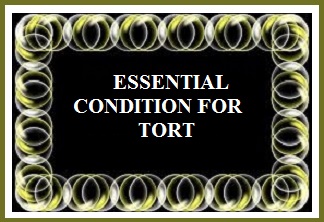CURRENT AFFAIRS
Get the most updated and recent current affair content on Padhaikaro.com
ESSENTIAL CONDITION FOR TORT
- IAS NEXT, Lucknow
- 18, Jan 2021

In rem = in the things itself.
General conditions of liability for a tort (How tort is committed).
Essential condition for a tort:-
- A wrongful act or omission.
- The wrongful act must result in causing legal damage to another.
- The wrongful act must be of such a nature as to give rise to a legal remedy.
What is a Wrongful act?
Wrongful act means any act, omission or misstatement which is violation of law especially the law.
Wrongful act = Infringing right of another
It includes (example) – illegal act, acts that are immoral in nature, anti-Social activities which results in a civil suit.
Legal Damages: – Not every damage is damage in the eyes of law. It must be damage which the law recognized such as damage. In other words, there must be legal injury or invasion of legal right, without it no action lies.
Legal Remedy: – Damages is the predominantly a remedy.
Example – There are any monetary payments made by dependant for the purpose of compensation to the victim for their injury, loss or pain is a legal remedy.

Damnum Sine Injuria – Damage without injury
Important maxims of tort:-
DAMNUM = DAMAGE
Sine = WITHOUT
INJURIA = INJURY
In this causing damage, however, substantially to another person is not actionable in law unless there is a violation of legal rights. Therefore, there will be no compensation for the plaintiff unless there is also a violation of the legal rights.
Act + Loss – Injury = Damnum Sine Injuria
Dependant’s act + Plaintiff loss – Plaintiff injury = Damnum Sine Injuria
Important case laws of Damnum Sine Injuria:-
Gloucester Grammar School Case – In this case, the defendant was the school master intentionally opened the school in front of the plaintiff school, causing damage to him. As due to an increase in competition the plaintiff has to reduce their fees from 30 to 12% per scholar per quarter. It was held that even through the plaintiff has suffered harm but there was no infringement of a legal right, therefore the defendant can’t be held liable.
Ushaben V. Bhagyalaxmi Chitra Mandir – In this case, the plaintiff sued the defendants for a permanent injunction as “Jai Santoshi Maa” was hurting the religious sentiments as a goddess was represented as jealous in the movie. No compensation was given as there was no violation of the legal right.
Injuria Sine Damnum – Injury Without Damage
It means an infringement of an absolute private right without any actual loss or damage. Therefore the plaintiff will be compensated if his legal right is violated even through there is no actual loss or damage is suffered.
Important case laws of Injuria Sine Damnum –
Ashby V. White – In this case, the plaintiff was a qualified voter at a parliamentary election, while the defendant was a returning officer. Plaintiff was confined by a returning officer due to which the plaintiff was not able to cast his vote. Through the party in the election was the election. Although the plaintiff didn’t suffer any loss by such a wrongful act.
Mens Rea Guilty Mind – In the law of tort act must be done with an evil motive or wrongful intention because in absence of a guilty mind act itself creates no guilty.
Simply means that mind must agree in the act the act must be done with wrongful intention but this rule has two exceptions –
- Absolute Liabilities
- Strict Liabilities
Difference between Law of Tort & Crime –
| Crime | Tort |
|
|